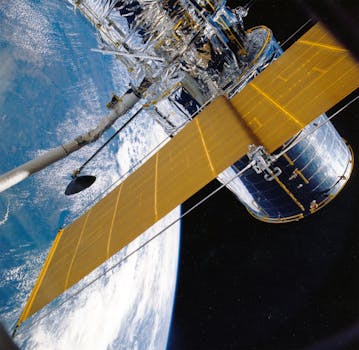
Beyond Earth: How Recent Advances in Satellite Tech are Shaping Global Communications
Beyond Earth: How Recent Advances in Satellite Tech are Shaping Global Communications. The world of satellite technology has witnessed tremendous growth in recent years, with significant advancements in space exploration and communication. These developments have transformed the way we connect with each other, enabling faster and more reliable global communications. In this article, we will delve into the latest innovations in satellite technology and their impact on global communications.
Satellite technology has come a long way since the launch of the first artificial satellite, Sputnik, in 1957. Today, thousands of satellites orbit the Earth, providing a wide range of services, including navigation, weather forecasting, and communication. The recent advances in satellite technology have been driven by the growing demand for global connectivity, particularly in remote and underserved areas. Companies such as SpaceX, Amazon, and OneWeb are leading the charge, launching constellations of satellites into low Earth orbit to provide high-speed internet connectivity.
The development of reusable rockets has been a significant factor in the advancement of satellite technology. SpaceX’s Falcon 9 rocket, for example, has successfully launched numerous satellites into orbit and returned to Earth, reducing the cost of access to space. This innovation has enabled companies to launch more satellites, increasing the overall capacity and coverage of satellite communications. Furthermore, the use of advanced materials and manufacturing techniques has led to the production of smaller, more efficient satellites, which can be launched at a lower cost.
The Impact of Satellite Technology on Global Communications
The impact of satellite technology on global communications has been profound. Satellite communications have enabled the connection of remote and underserved communities, providing access to essential services such as healthcare, education, and banking. Satellite technology has also enabled the growth of global commerce, facilitating international trade and communication. The use of satellite communications has also improved the effectiveness of emergency response and disaster relief efforts, enabling rapid communication and coordination between responders and affected communities.
In addition to these benefits, satellite technology has also enabled the development of new technologies, such as the Internet of Things (IoT). The IoT refers to the network of physical devices, vehicles, and other items that are embedded with sensors, software, and connectivity, allowing them to collect and exchange data. Satellite technology has enabled the extension of IoT networks into remote and underserved areas, enabling the monitoring and management of critical infrastructure, such as pipelines, grids, and transportation systems.
Challenges and Opportunities in Satellite Technology
Despite the many advances in satellite technology, there are still significant challenges to be addressed. One of the major challenges is the issue of space debris, which poses a significant risk to operational satellites and other space-based assets. The growth of satellite constellations has also raised concerns about the potential for interference and congestion in the radio frequency spectrum. Furthermore, the development of satellite technology has also raised important questions about regulation, governance, and the long-term sustainability of space activities.
However, these challenges also present opportunities for innovation and growth. The development of new technologies, such as advanced propulsion systems and more efficient satellite designs, is expected to continue to drive down the cost of access to space. The growth of the satellite industry is also expected to create new job opportunities and stimulate economic growth, particularly in regions with limited connectivity. Furthermore, the use of satellite technology has the potential to address some of the world’s most pressing challenges, such as climate change, poverty, and inequality.
Conclusion
In conclusion, recent advances in satellite technology are transforming the world of global communications, enabling faster and more reliable connectivity across the globe. The development of reusable rockets, smaller satellites, and advanced materials has driven down the cost of access to space, enabling the launch of more satellites and increasing the overall capacity and coverage of satellite communications. While there are still significant challenges to be addressed, the opportunities presented by satellite technology are vast and have the potential to address some of the world’s most pressing challenges.


